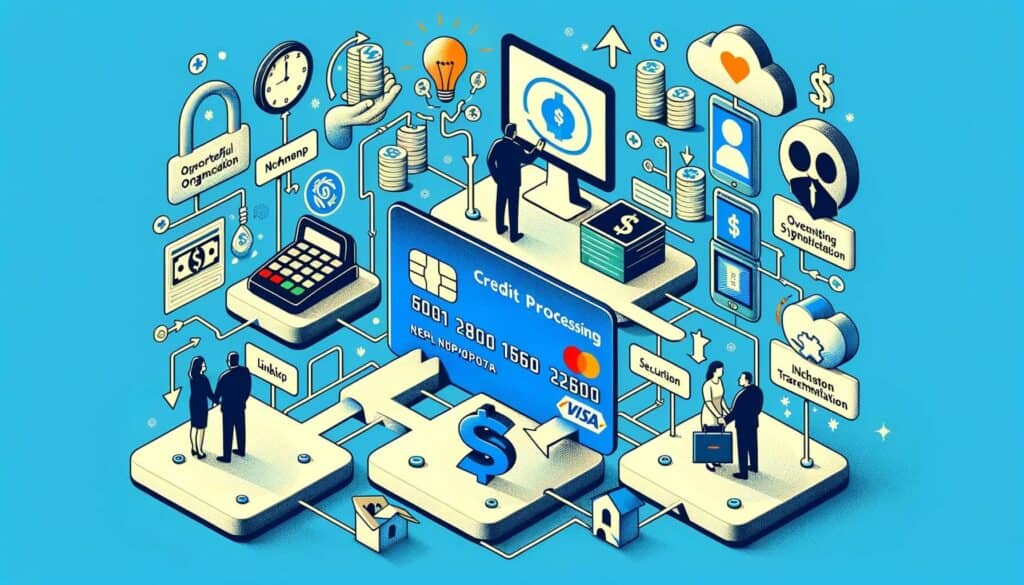
By Cindy Gardea February 14, 2025
In today’s digital age, credit card processing has become an essential tool for non-profit organizations. With the majority of transactions being conducted electronically, it is crucial for non-profits to offer convenient and secure payment options to their donors. Credit card processing allows non-profits to accept donations online, over the phone, or in person, making it easier for supporters to contribute to their cause.
In this comprehensive guide, we will explore the benefits of credit card processing for non-profit organizations, the different types of solutions available, how to choose the right provider, and best practices for setting up and managing credit card processing.
Benefits of Credit Card Processing for Non-Profit Organizations

1. Increased Donations: By accepting credit card payments, non-profit organizations can tap into a larger donor base. Many individuals prefer the convenience of using their credit cards to make donations, as it allows them to contribute instantly without the hassle of writing a check or sending cash.
2. Recurring Donations: Credit card processing enables non-profits to set up recurring donations, allowing donors to contribute on a regular basis. This not only provides a steady stream of income for the organization but also makes it easier for donors to support their cause consistently.
3. Improved Cash Flow: With credit card processing, non-profits can receive donations quickly, often within a few business days. This helps improve cash flow and allows organizations to allocate funds more efficiently towards their programs and initiatives.
4. Enhanced Donor Experience: Offering credit card processing options provides a seamless and user-friendly experience for donors. They can easily make donations online or through mobile devices, eliminating the need for manual processes and paperwork.
5. Increased Transparency: Credit card processing provides a transparent record of all transactions, making it easier for non-profits to track and manage their finances. This transparency helps build trust with donors and ensures accountability in the use of funds.
Types of Credit Card Processing Solutions for Non-Profit Organizations

1. Online Payment Gateways: Online payment gateways are a popular choice for non-profits as they allow organizations to accept credit card payments securely through their website. These gateways encrypt sensitive information, ensuring the safety of donor data.
2. Mobile Payment Solutions: With the rise of smartphones, mobile payment solutions have become increasingly popular. Non-profits can use mobile payment apps or devices to accept credit card payments at events, fundraisers, or even door-to-door campaigns.
3. Virtual Terminals: Virtual terminals are ideal for non-profits that receive donations over the phone. These terminals allow organizations to manually enter credit card information, process payments, and send receipts to donors.
4. Point of Sale (POS) Systems: Non-profits with physical locations, such as thrift stores or gift shops, can benefit from POS systems. These systems integrate credit card processing with inventory management, making it easier to track sales and manage donations.
Choosing the Right Credit Card Processing Provider for Non-Profit Organizations

When selecting a credit card processing provider, non-profit organizations should consider the following factors:
1. Pricing: Non-profits should look for providers that offer competitive rates and transparent pricing structures. It is important to understand all fees associated with credit card processing, including transaction fees, monthly fees, and any additional charges.
2. Security: Donor data security is of utmost importance for non-profits. It is crucial to choose a provider that complies with Payment Card Industry Data Security Standard (PCI DSS) requirements and offers robust security measures to protect sensitive information.
3. Integration: Non-profits should consider providers that offer seamless integration with their existing systems, such as donor management software or accounting platforms. This integration streamlines processes and reduces manual data entry.
4. Customer Support: Reliable customer support is essential for non-profits, especially during critical fundraising periods. Look for providers that offer 24/7 support and have a reputation for excellent customer service.
Setting Up Credit Card Processing for Non-Profit Organizations: Step-by-Step Guide

1. Determine Your Needs: Assess your organization’s requirements and identify the type of credit card processing solution that best suits your needs. Consider factors such as the volume of transactions, types of donations, and the platforms you will be using.
2. Research Providers: Conduct thorough research to identify credit card processing providers that specialize in serving non-profit organizations. Read reviews, compare pricing, and evaluate the features and services offered by each provider.
3. Evaluate Security Measures: Ensure that the provider you choose prioritizes data security and complies with PCI DSS requirements. Look for features such as tokenization and encryption to protect donor information.
4. Review Contract Terms: Carefully review the contract terms and conditions before signing up with a provider. Pay attention to any hidden fees, cancellation policies, and contract length.
5. Set Up an Account: Once you have selected a provider, follow their instructions to set up an account. This typically involves providing your organization’s information, bank account details, and completing any necessary paperwork.
6. Integrate with Your Systems: If you are using donor management software or other platforms, work with your provider to integrate the credit card processing solution with your existing systems. This will ensure a seamless flow of data and simplify your operations.
7. Test and Train: Before going live, thoroughly test the credit card processing solution to ensure it is functioning correctly. Train your staff on how to use the system and address any questions or concerns they may have.
8. Launch and Promote: Once everything is set up, promote your new credit card processing capabilities to your donors and supporters. Highlight the convenience and security of the system to encourage more donations.
Best Practices for Credit Card Processing in Non-Profit Organizations
1. Educate Donors: Provide clear instructions on how to make credit card donations and explain the security measures in place to protect their information. This will help build trust and encourage more donors to contribute.
2. Optimize Donation Forms: Make the donation process as simple and user-friendly as possible. Use clear and concise forms, minimize the number of required fields, and offer suggested donation amounts to streamline the process.
3. Regularly Update Security Measures: Stay up to date with the latest security practices and technologies to protect donor data. Regularly review and update your systems to ensure they meet industry standards.
4. Provide Donation Receipts: Send timely and accurate donation receipts to your donors. This not only acknowledges their contribution but also serves as a record for tax purposes.
5. Analyze Data: Utilize the data collected through credit card processing to gain insights into donor behavior and preferences. This information can help you tailor your fundraising strategies and improve donor engagement.
Common Challenges and Solutions in Credit Card Processing for Non-Profit Organizations
1. High Processing Fees: Non-profits often face high processing fees, which can eat into their fundraising revenue. To mitigate this challenge, negotiate with providers for lower rates or explore options for discounted non-profit pricing.
2. Donor Data Security: Protecting donor data is a top concern for non-profits. Implement robust security measures, such as encryption and tokenization, and regularly update your systems to stay ahead of potential threats.
3. Payment Disputes: Occasionally, donors may dispute credit card charges, leading to chargebacks. To minimize this risk, clearly communicate your refund and cancellation policies, provide excellent customer service, and promptly address any donor concerns.
4. Integration Issues: Integrating credit card processing with existing systems can be challenging. Work closely with your provider and IT team to ensure a smooth integration process and resolve any compatibility issues.
Frequently Asked Questions (FAQs) about Credit Card Processing for Non-Profit Organizations
Q1. What are the fees associated with credit card processing for non-profit organizations?
A1. Fees vary depending on the provider and the type of transactions. Common fees include transaction fees, monthly fees, and chargeback fees. It is important to review the pricing structure and understand all associated costs before choosing a provider.
Q2. How long does it take to set up credit card processing for a non-profit organization?
A2. The setup time can vary depending on the provider and the complexity of your requirements. It can range from a few days to a few weeks. It is advisable to start the process well in advance to ensure a smooth transition.
Q3. Can non-profit organizations accept credit card donations over the phone?
A3. Yes, non-profit organizations can accept credit card donations over the phone using virtual terminals. These terminals allow organizations to manually enter credit card information and process payments securely.
Q4. How can non-profit organizations ensure the security of donor data?
A4. Non-profit organizations should choose credit card processing providers that comply with PCI DSS requirements. Additionally, implementing encryption, tokenization, and regular security updates can help protect donor data.
Q5. Can non-profit organizations set up recurring donations through credit card processing?
A5. Yes, credit card processing allows non-profit organizations to set up recurring donations. Donors can choose to contribute on a regular basis, providing a steady stream of income for the organization.
Conclusion
Credit card processing has revolutionized the way non-profit organizations collect donations. By offering convenient and secure payment options, non-profits can increase donations, improve cash flow, and enhance the donor experience. Choosing the right credit card processing provider, setting up the system correctly, and following best practices are crucial for successful implementation.
While challenges such as high processing fees and donor data security exist, they can be overcome with careful planning and proactive measures. By leveraging credit card processing effectively, non-profit organizations can maximize their fundraising efforts and make a greater impact on their causes.
